|
|
|
Sort Order |
|
|
|
Items / Page
|
|
|
|
|
|
|
| Srl | Item |
| 1 |
ID:
119058
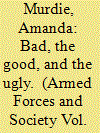

|
|
|
|
|
| Publication |
2013.
|
| Summary/Abstract |
Does civil-military conflict harm military effectiveness? Most previous empirical literature on the effects of civil-military conflict has utilized dichotomous indicators of the presence or absence of overall civilian control. However, the extant theoretical literature is clear that mid-levels of civil-military conflict could be good for innovation and overall decision making. In line with these arguments, the author argues that we should not expect all civil-military conflict to harm military effectiveness and, by extension, international crisis bargaining outcome. Instead, some civil-military conflict should have a positive effect on the overall success of the military. Utilizing new events data that captures the level of civil-military conflict cross nationally from 1990 to 2004, the author examines how civil-military conflict actually has an inverse U-shaped relationship with crisis success. This project also adds to the theoretical literature by examining variations across different degrees of civil-military conflicts, drawing attention to the usefulness of mid-range civil-military "friction."
|
|
|
|
|
|
|
|
|
|
|
|
|
|
|
|
| 2 |
ID:
167292
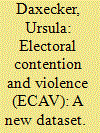

|
|
|
|
|
| Summary/Abstract |
Recent elections in Afghanistan, Bangladesh, Côte d’Ivoire, Egypt, Iraq, Kenya, Nigeria, and Pakistan have displayed substantial contestation and violence. A growing literature explores the causes and consequences of electoral contention and violence, but researchers lack comprehensive, disaggregated data establishing a substantive link between elections and violence. The Electoral Contention and Violence (ECAV) dataset conceptualizes electoral contention as nonviolent or violent events of contestation by state or non-state actors related to national elections. The data contain more than 18,000 events of election-related contention covering 136 countries holding competitive national elections between 1990 and 2012. This article describes the scope of ECAV, presents the project’s definition of electoral contention and the variables included, and outlines the coding procedure. We then compare ECAV to other datasets on electoral contention. Cross-national and subnational analyses of electoral competition and violence show that the data are useful for assessing the global and subnational implications of existing theories. ECAV addresses current data limitations by focusing on election-related contention, by using clear criteria to determine whether events are election-related, and by identifying the timing, geocoded location, and actors involved.
|
|
|
|
|
|
|
|
|
|
|
|
|
|
|
|
| 3 |
ID:
112415
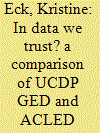

|
|
|
|
|
| Publication |
2012.
|
| Summary/Abstract |
In recent years, several large-scale data-collection projects have produced georeferenced, disaggregated events-level conflict data which can aid researchers in studying the microlevel dynamics of civil war. This article describes the differences between the two leading conflict events datasets, the Uppsala Conflict Data Program Georeferenced Events Dataset (UCDP GED) and the Armed Conflict Location Events Dataset (ACLED), including their relative strengths and weaknesses. The aim of the article is to provide readers with some guidelines as to when these datasets should be used and when they should be avoided; it finds that those interested in subnational analyses of conflict should be wary of ACLED's data because of uneven quality-control issues which can result in biased findings if left unchecked by the researcher. The article concludes that those interested in non-violent events such as troop movements have only ACLED to choose from, since UCDP has not coded such data, but again warns researchers to be wary of the quality of the data. Finally, while the creation of these datasets is a positive development, some caveats are raised in relation to both datasets about the reliance on media sources.
|
|
|
|
|
|
|
|
|
|
|
|
|
|
|
|
| 4 |
ID:
122903
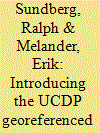

|
|
|
|
|
| Publication |
2013.
|
| Summary/Abstract |
This article presents the UCDP Georeferenced Event Dataset (UCDP GED). The UCDP GED is an event dataset that disaggregates three types of organized violence (state-based conflict, non-state conflict, and one-sided violence) both spatially and temporally. Each event - defined as an instance of organized violence with at least one fatality - comes with date, geographical location, and identifiers that allow the dataset to be linked to and merged with other UCDP datasets. The first version of the dataset covers events of fatal violence on the African continent between 1989 and 2010. This article, firstly, introduces the rationale for the new dataset, and explains the basic coding procedures as well as the quality controls. Secondly, we discuss some of the data's potential weaknesses in representing the universe of organized violence, as well as some potential biases induced by the operationalizations. Thirdly, we provide an example of how the data can be used, by illustrating the association between cities and organized violence, taking population density into account. The UCDP GED is a useful resource for conflict analyses below the state and country-year levels, and can provide us with new insights into the geographical determinants and temporal sequencing of warfare and violence.
|
|
|
|
|
|
|
|
|
|
|
|
|
|
|
|
| 5 |
ID:
109192
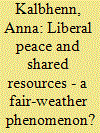

|
|
|
|
|
| Publication |
2011.
|
| Summary/Abstract |
The aim of this article is to empirically analyse liberal peace arguments in the context of shared river basins. In particular, it argues that counter to the water war hypothesis, sharing a river need not necessary lead to conflict over the shared resource: relying on liberal arguments, joint democracy is expected to facilitate trust and thus cooperation over transboundary rivers. Furthermore, by mitigating asymmetries, facilitating (implicit) side-payments and issue linkage, both economic and political interlinkages may encourage cooperation over shared rivers. Previous work suggests that these factors might be a 'fair-weather' phenomenon, that is, that they play a role only for problems that are easy to solve. In this article, liberal effects are allowed to vary with the difficulty of the underlying problem by separating different issues and geographic situations. Empirically, the article focuses on intergovernmental behaviour using a new dataset on transboundary water events covering all international basins for a period of eleven years (1997-2007). The results show that indeed liberal peace factors matter with respect to intergovernmental interaction over shared river basins and the effect of joint democracy is more prominent under 'fair-weather' conditions.
|
|
|
|
|
|
|
|
|
|
|
|
|
|
|
|
| 6 |
ID:
120769


|
|
|
|
|
| Publication |
2013.
|
| Summary/Abstract |
Why does a dissident group go through phases of violence and nonviolence? Many studies of states and dissidents examine related issues by focusing on structural or rarely changing factors. In contrast, some more recent work focuses on dynamic interaction of participants. We suggest forecasting state-dissident interaction using insights from this dynamic approach while also incorporating structural factors. We explore this question by offering new data on the behavior of groups and governments collected using automated natural language processing techniques. These data provide information on who is doing what to whom at a directed-dyadic level. We also collected new data on the attitudes or sentiment of the masses using novel automated techniques. Since obtaining valid and reliable time-series public opinion data on mass attitudes towards a dissident group is extremely difficult, we have created automated sentiment data by scraping publicly available information written by members of the population and aggregating this information to create a pollof opinion at a discrete time period. We model the violence and nonviolence perpetrated by two groups: the Tamil Tigers in Sri Lanka and the Moro Islamic Liberation Front in the Philippines. We find encouraging results for predicting future phase shifts in violence when accounting for behaviors modeled with our data as opposed to models based solely on structural factors.
|
|
|
|
|
|
|
|
|
|
|
|
|
|
|
|
| 7 |
ID:
154744
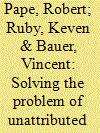

|
|
|
|
|
| Summary/Abstract |
High rates of missing perpetrator information in political violence data pose a serious challenge for studies into militant group behavior and the microdynamics of conflict more generally. In this article we introduce multiple imputation (MI) as the best available method for minimizing the impact of missing perpetrator information on quantitative analyses of political violence, a method that can easily be incorporated into most quantitative research designs. MI will produce unbiased attributions when the reasons for missingness are known and can be controlled for using observed variables, rendering responsibility for unclaimed attacks, “missing at random” (MAR) – which we show is a reasonable assumption in the case of political violence based on current theory of militant group claiming. We lay out the logics and steps of MI, identify variables and data sources, and demonstrate that MI produced better results in the case of the Pakistani Taliban’s response to drone strikes.
|
|
|
|
|
|
|
|
|
|
|
|
|
|
|
|
|
|
|
|
|